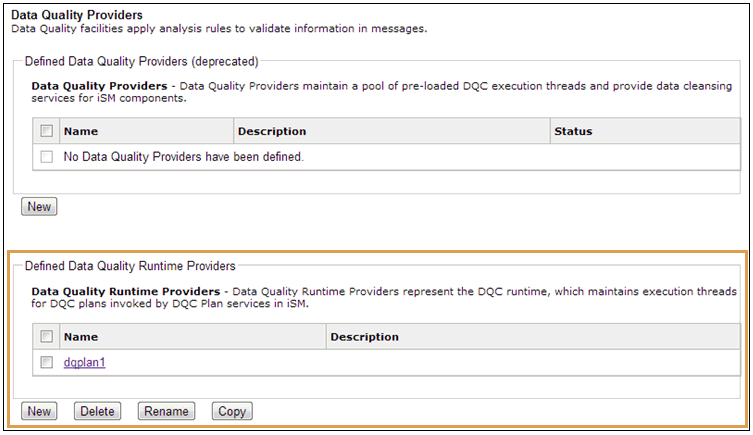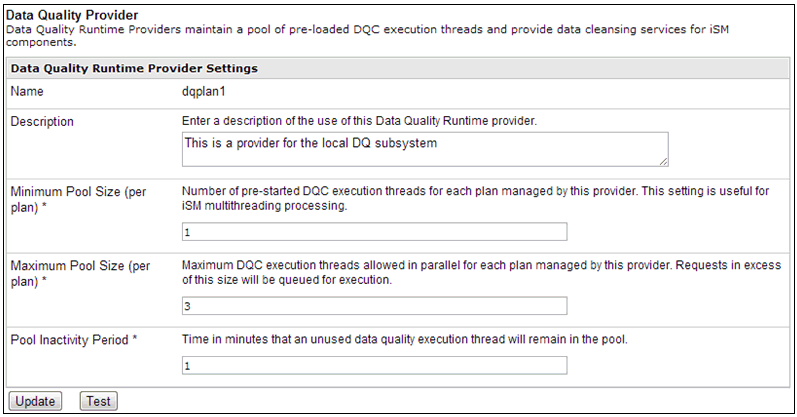Data Quality Center Service (Document-Driven, Pooling) (com.ibi.agents.XDDQAgent2)
|
Topics: |
Syntax:
com.ibi.agents.XDDQAgent2
iIT Service Object:
DQS: Data Quality Service Agent - Document Driven (pooling)
Description:
This service marshals data from an input document and processes data using an iWay Data Quality Runtime Provider.
Parameters:
|
Parameter |
Description |
|---|---|
|
Data Quality Runtime Provider * |
Specify the configured iWay Data Quality Runtime Provider that should be invoked. |
|
DQC plan file * |
Specify the location of the iWay Data Quality Center (DQC) plan file containing the logic for the data quality operation. |
|
Runtime Config File (Optional) |
Specify the location of the iWay DQC runtime configuration file. This file is used to define an iWay DQC runtime variable, such as JDBC data sources or folder shortcuts used in the plan. |
|
XPath Expression * |
Specify an XPath expression that will return one or more elements from the input document that will be used as input records when the iWay DQC plan is invoked. |
|
XPath Namespace Map |
If the input document contains namespaces, then this parameter specifies the configured namespace map to be used when evaluating XPath expressions. |
|
Replace or Preserve? * |
Determines whether the children of the record element in the output document should be preserved (appending the result of the iWay DQC plan execution as new child elements), or should the original children be replaced with the iWay DQC plan results. Select one of the following options from the drop-down list:
By default, replace is selected. |
Edges:
The following table lists the available line edges for the Data Quality Center Service (Document-Driven, Pooling) (com.ibi.agents.XDDQAgent2).
|
Line Edge |
Description |
|---|---|
|
OnError |
Error |
|
OnSuccess |
Success |
|
OnFailure |
Failure |
|
OnCustom |
|
Configuring Data Quality Runtime Providers
In the iWay Service Manager (iSM) Administration Console, the Data Quality Providers area now includes a second group called Defined Data Quality Runtime Providers, as shown in the following image.

The former group (Defined Data Quality Providers) is now deprecated. It is recommended to migrate to the new provider (Data Quality Runtime Provider). The original Data Quality Provider represented a single iWay DQC plan. This required you to configure one Data Quality Provider for each iWay DQC plan The new Data Quality Runtime Provider represents iWay DQC runtime. A single Data Quality Runtime Provider can be used to manage all iWay DQC plans.
The new Data Quality Runtime Provider is configured by setting pooling parameters for the local instance of iWay DQC that is installed with iSM. In a future iSM release, it will be possible to configure a remote instance of iWay DQC.
The following image shows the Data Quality Runtime Provider Settings pane.

The pools enable iSM to optimize access to iWay DQC, consistent with the reentrancy of the iWay DQC subsystem in use. Note that these pool settings apply to each iWay DQC plan that is managed by the provider. Thus, if the iWay DQC runtime loads 3 separate plans and the Maximum Pool Size parameter is set to 3, then a maximum of 9 execution threads will be pooled.
The Data Quality Runtime Provider supports the following services:
- Data Quality Center Service (Document-Driven, Pooling)
com.ibi.agents.XDDQAgent2
- Data Quality Center Service (User Parameter-Driven, Pooling)
com.ibi.agents.XDDQAgent2UserParm
The document-driven version of the service has the same functionality as the deprecated Data Quality Center Service (com.ibi.agents.XDDQAgent), except:
- It uses the new Data Quality Runtime Provider.
- Because the Data Quality Runtime Provider represents the iWay DQC runtime, rather than a specific iWay DQC plan, the service must be configured with the path to the plan file (and optional runtime configuration file).
For more information about using Data Quality Runtime Providers with one of the supported services, see Using the Data Quality Center Service (User Parameter-Driven, Pooling).